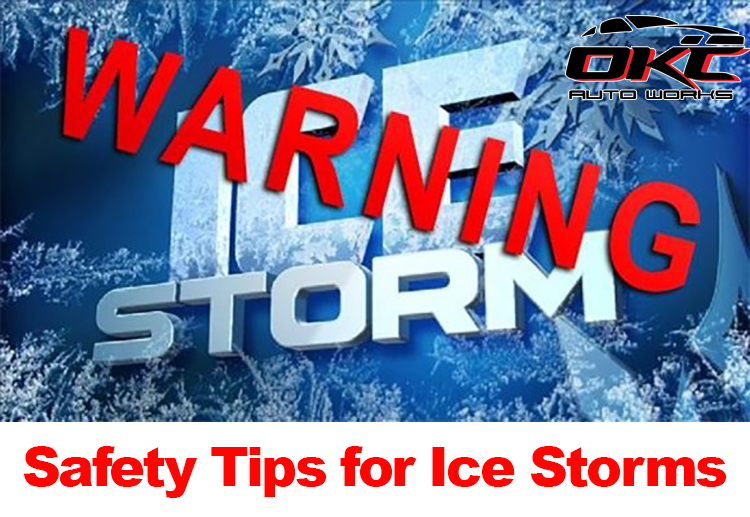While it is not yet November, here we are already dealing with our first (of possibly many) ice storms of the year. Although it is currently fall and ice storms could devastating in the short term for driving, as well as for outdoor plants and shrubs, the good news is that its effects will be short-term given weather temps in the fall typically do not stay low for long in Oklahoma. In fact, within a few days, temps should be back up to the low 50s and 60s in our state. Even still, we thought it might be a good time to go over safety tips for Ice and snow since there is no doubt it will prove useful information as we progress from fall into the winter months.
Ice storms can bring down trees and power lines, causing power outages and creating electrical dangers. OKC Auto Works wants everyone to know how to stay safe and warm after ice storms. If you must venture outside, be alert to the possibility of electrical risks. You should avoid any downed power lines and be alert to the possibility that tree limbs or debris may hide an electrical hazard. You should treat all power lines as though they are live and dangerous, as well as everything near the powerlines.
Staying warm can be problematic when the power it out. You may want to consider staying elsewhere until your power can be restored, this is especially the case if you have young children or elderly folks living with you. If you choose to say home, there are ways to stay warm, which we will discuss later in the article. If you have a generator, only use it if you know how to operate it properly without hurting yourself or others. Remember, too, that after an outage, power can return in spikes so keep your electronics safe by unplugging them. Also, leave a light on so that you know when power has returned so that you can plug your appliances and equipment back in at that time.
How to stay warm
If the power goes out in ice storms, or other cold-weather events, temperatures can drop significantly. First, keep all doors to the outside shut and use towels to block drafts coming in from window and door cracks. You can insulate windows with blankets, this is especially true with black blankets as black draws heat from the sun. The goal is to keep as much heat inside the house as possible. Turn the faucets on to a trickle as this will help prevent your pipes from freezing. You can also wrap pipes in insulation or newspaper for added prevention of pipes bursting. Additionally, open kitchen and bathroom cabinet doors to allow warmer air to circulate around the plumbing.
Stay inside and dress in warm, wear layered clothing. Close off all unnecessary rooms so you have less area to worry about keeping warm. When using an alternative heat source, follow operating instructions, use fire safeguards and be sure to properly ventilate so as not to cause a fire or other issues. Don’t rely on gas stoves, charcoal grills, or other open-flame heat sources. Deadly carbon monoxide gas – which is odorless and invisible – may build up in your home.
Don’t take risks on the road or in your home
Avoid driving when conditions include sleet, freezing rain or drizzle, snow, or dense fog. It is always best during ice storms to just stay home! However, if travel is necessary, keep a disaster supply kit in your vehicle. Do not travel alone if you can help it and let someone know where you are going and your expected arrival time. Drive more slowly and cautiously. Be sure to give more distance between your vehicle and others on the road so you have more time to slow down. Be sure when parking to avoid parking under trees as they are more prone to falling when weighed down by ice. Even if you feel confident driving in inclement weather, not everyone on the road is equipped for such driving, so watch out for other drivers.
For more tips on driving in slick weather, click here.
Avoid carbon monoxide dangers
Carbon monoxide poisoning, fire, and electric shock are threats during an outage. Make sure to place generators away from doors, windows, and vents that could allow carbon monoxide to come indoors. If you have gas heat or plan to use a generator during outages, it would be a good idea to install carbon monoxide alarms. It’s best to put one on every floor in a centrally located area. If the alarm sounds move quickly to fresh air either outdoors or by an open window. Call for help and remain there until emergency personnel arrives. Be mindful of gas fumes while cooking. Asphyxiation is a high risk when preparing hot foods during a power outage.
Keep stock of non-perishable foods
It’s best to maintain a three-day supply of water and non-perishable food at home, especially during winter weather and ice storms. Batteries, flashlights, and a radio are also good backup supplies. Stockpile items like fruit bars, nut butter (almond butter, peanut butter, etc), nuts and trail mixes, crackers, and canned juices. Keep refrigerator and freezer doors closed so that your frozen and cold foods do not perish as quickly.
While we know this current storm will pass soon with warmer weather soon to follow, it is a good idea to go ahead and get prepared for this winter, which will be here soon enough. There are things you will want to do with your vehicle to get it winter-ready, as well. Last month we discussed some maintenance items you don’t want to ignore, which is certainly something to look at while getting your car prepared for cooler weather.

